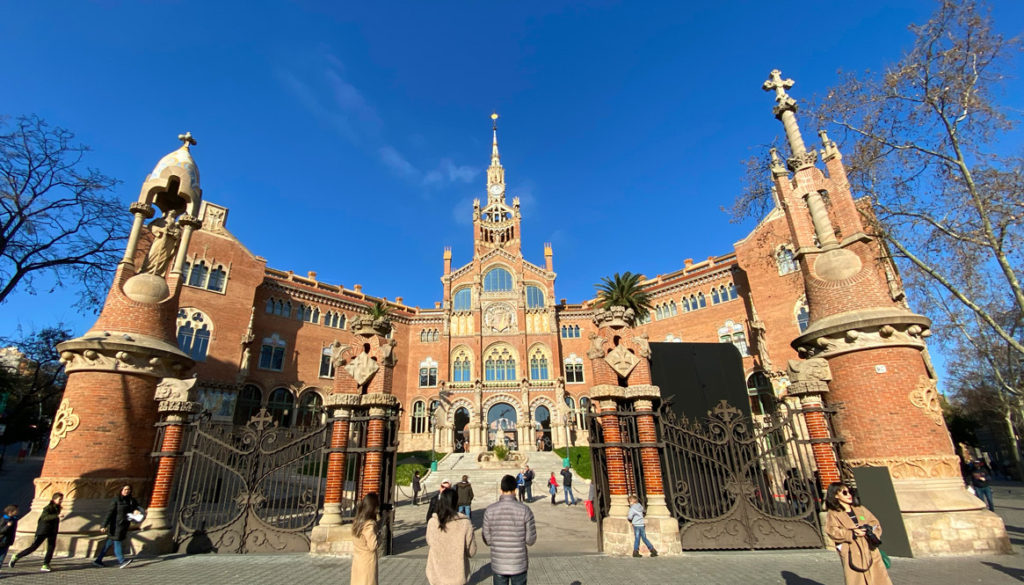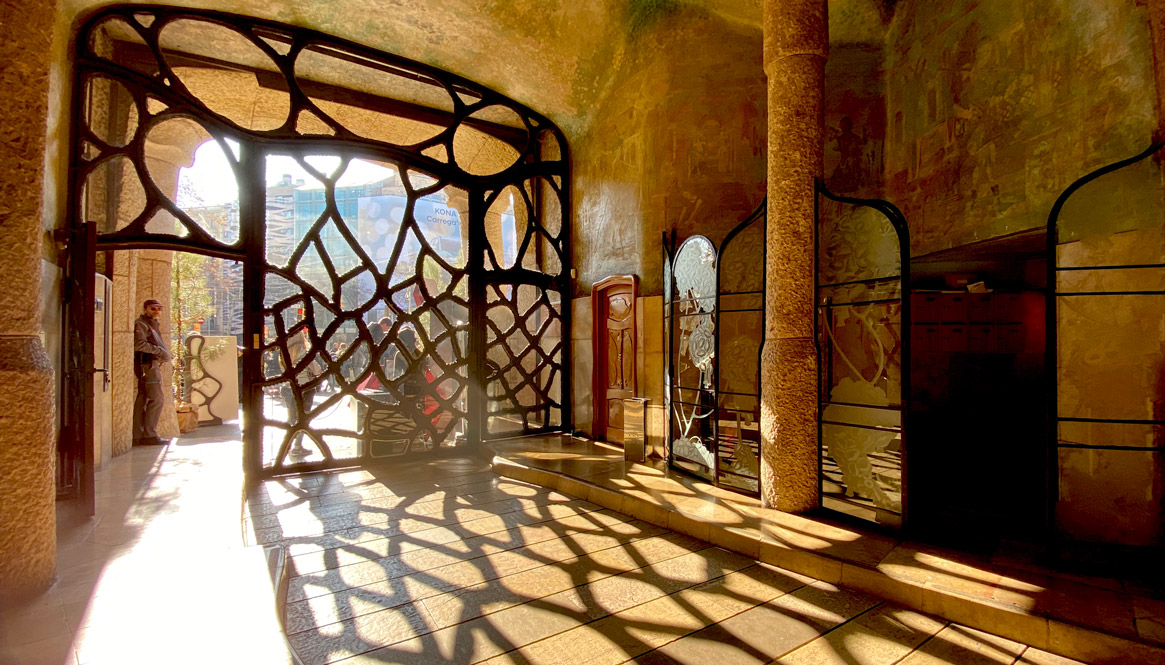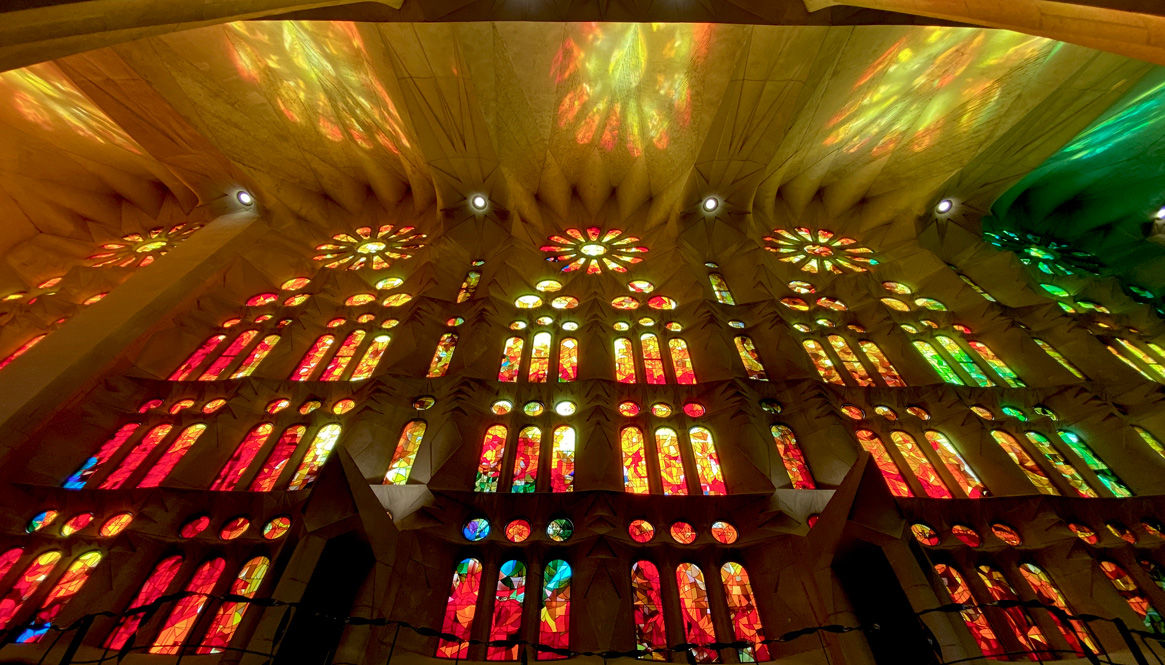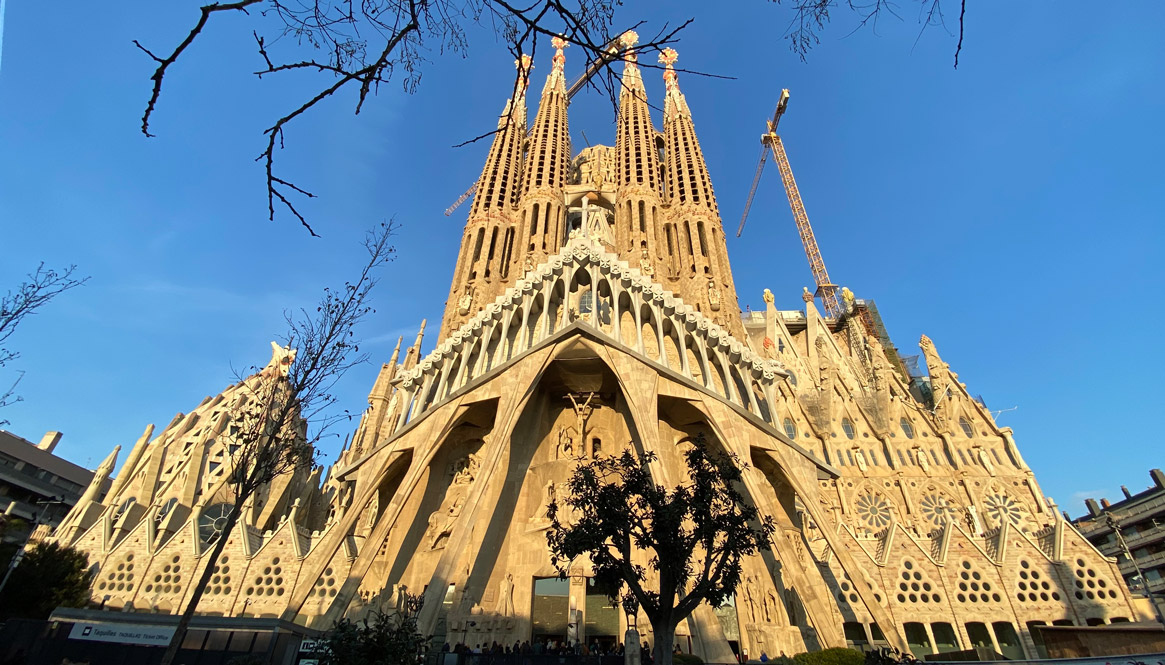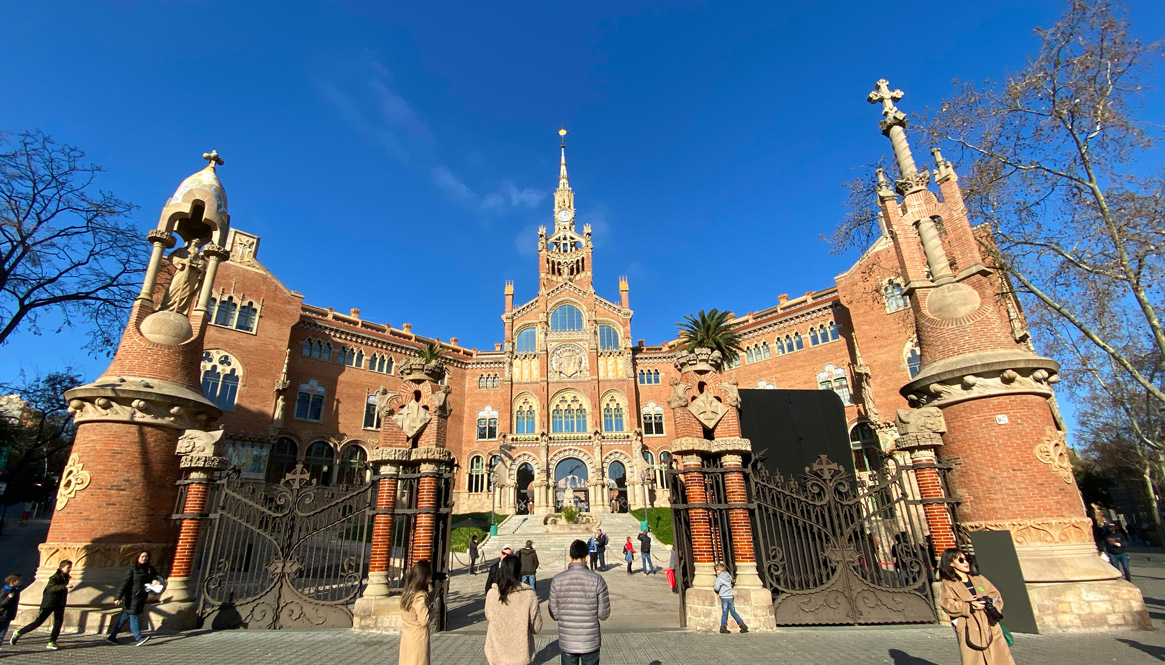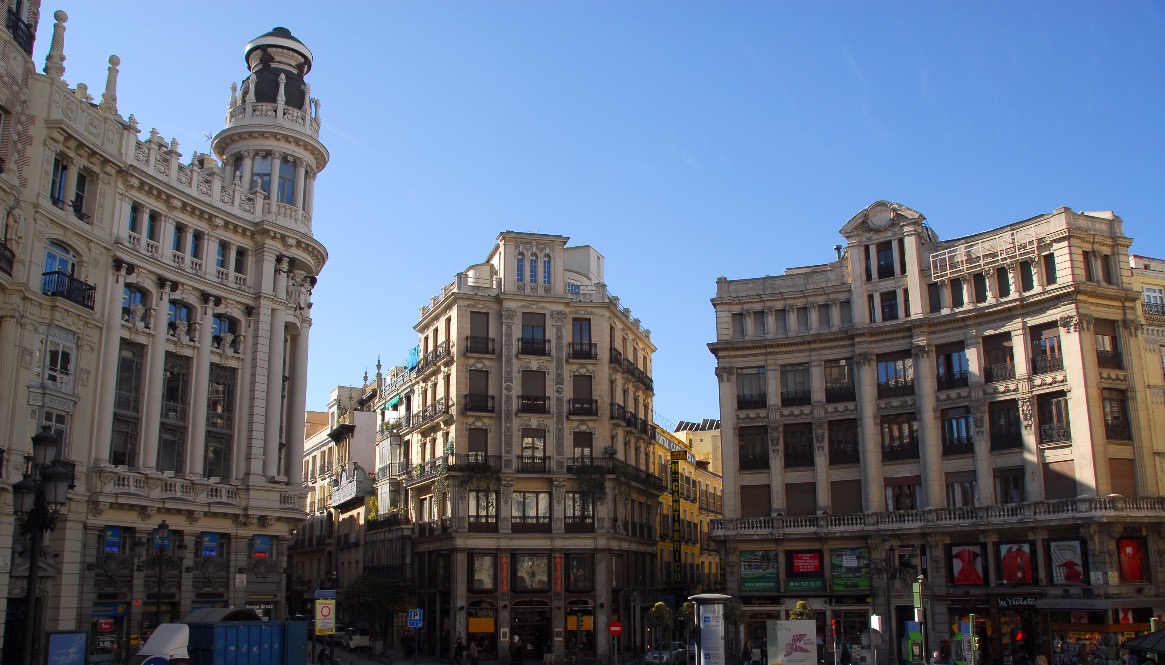Check out the awe-inspiring Hospital De Sant Pau, Barcelona
Would you ever think of a hospital as ‘awe-inspiring’ for its architecture and design? I wouldn’t!
But the former Hospital de la Santa Creu i Sant Pau in Barcelona is in a class of its own. Its the most beautiful hospital I’ve ever seen. It’s no surprise that it is designated as a UNESCO world heritage site. Its so beautiful that patients would feel better just being in this gorgeous hospital. More importantly, they say that patient care was exceptional at the hospital. The hospital has been part of the Catalan and Barcelona story for the last 6 centuries, being an integral part of its modernization, innovations, and growth. It is a place of pride for Catalonia and Catalonian history.
Most recently, Hospital De Sant Pau was architected by the famous public figure of Barcelone – Lluís Domènech i Montaner. He designed the building in the modernisme style. Lluís Domènech i Montaner was a leading intellectual and policymaker. His influence in Barcelona was immense at the turn of the 20th century. Just as the original hospital is a landmark in the secular Gothic architecture, Hospital De Sant Pau is a tribute to the Modernisme Catalan Art Nouveau.
Contents
- Scaled model of Hospital de Sant Pau, Barcelona
- Hypostyle Hall
- Underground Hospital Hallways
- Sant Salvador Pavilion
- Nostra Senyora de la Mercè Pavilion
- Sant Rafael Pavilion
- Sant Leopold Pavillion
- Sant Manuel Pavillion
- Hospital Sant Pau, end Building
- Operations House in Hospital de Sant Pau
- Santa Apol·lònia Pavillion
- The Administrative Pavillion
- Lluis Domenech i Montaner – The Architect and Visionary
- Milestones Dates in the History of Sant Pau Hospital
- Extended Campus
- Contact Information
- More of Our Articles from Spain
- 8 Heartwarming Travel Stories of Hope, Love and Life during the COVID-19 Pandemic in 2020
- Luxurious Casa Míla Barcelona, a Desirable Address by Gaudi
- 25 Famous Monuments of Barcelona – Spain’s Top Architectural Gems
- Gaudi’s Park Güell of Barcelona, a Photo Gallery
- La Sagrada Familia a Barcelona Landmark, in Pictures
- Check out the awe-inspiring Hospital De Sant Pau, Barcelona
- How to Eat Like a Local in Barcelona, as Vegetarian
- What, When, How of the Best Pintxos in Barcelona
- Madrid, Spain
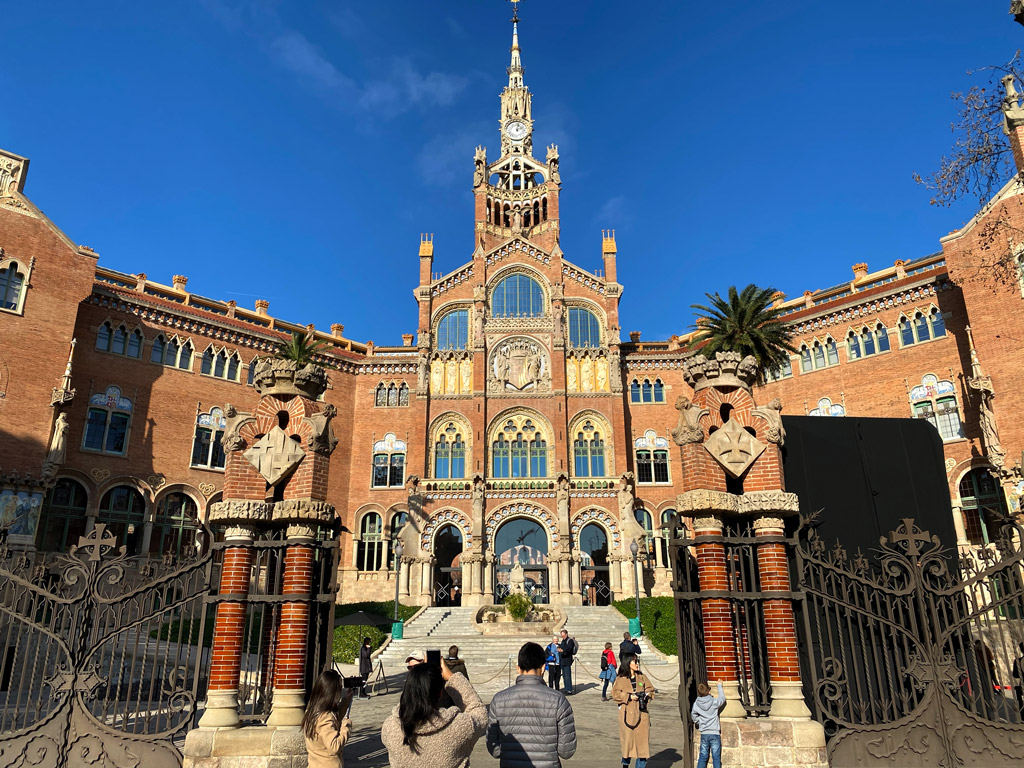
After being an active hospital for 600 years, the hospital departments have been moved to newer buildings nearby. Today, the complex is restored to its original glory and several structures have been converted to exhibitions and galleries about the hospital, art, and culture of Catalonia.
To visit the hospital, we bought our tickets to the right of the main entrance from the street. The self-guided discovery tour starts at an exhibition hall and galleries that then lead to underground hallways, which then emerge into Sant Salvador pavilion, then to the outdoors.
Scaled model of Hospital de Sant Pau, Barcelona
As the scaled model of Hospital De Sant Pau shows below, the hospital has an imposing building at the entrance, with a beautiful hospital complex behind it. Each building used to house one or more departments. The buildings (pavilions) open to a central area in the middle and are also connected by underground passages.
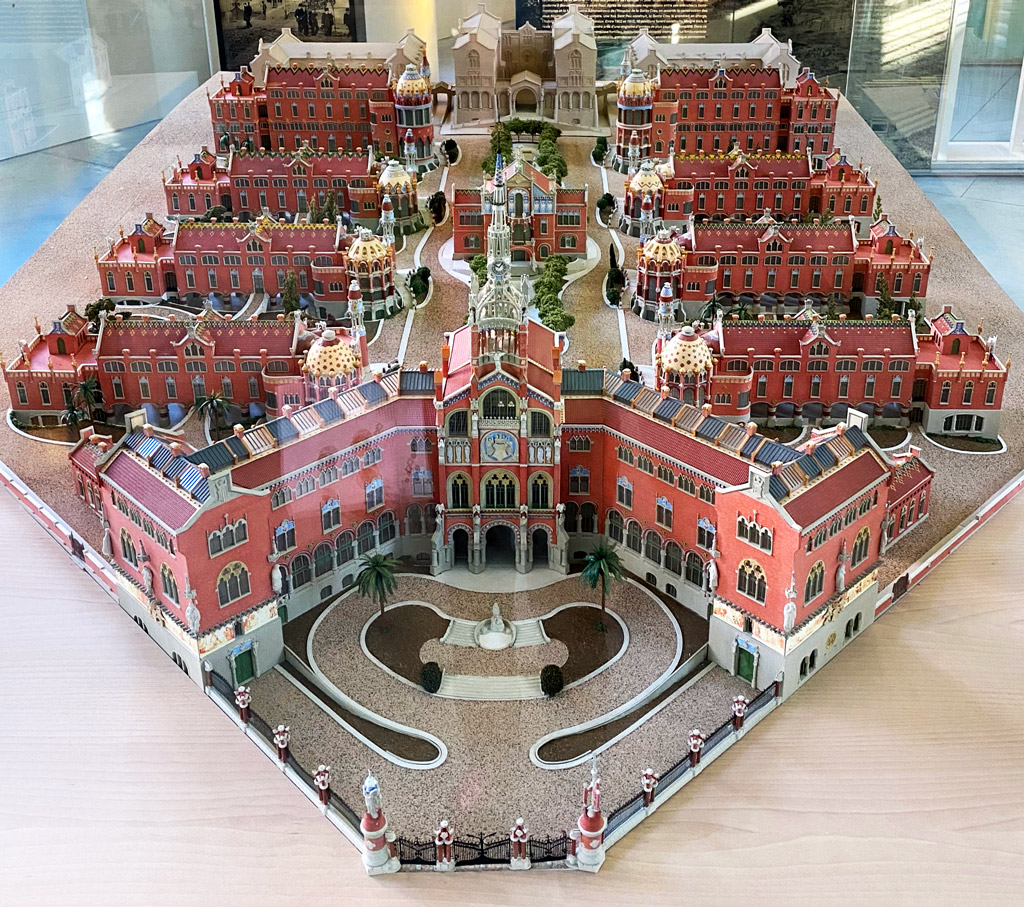
As can be seen in the model, the hospital has a symmetric, rectangular layout, bookended by two large buildings – a dominating entrance (Administrative hall) and a large brown building at the end. Perpendicular to the main building is a long outdoor courtyard, lined by 4 rectangular pavilions on each side, the operations house in the center and spiral staircases leading into the underground hallways.
The pavilion buildings look symmetric and very much the same from a distance, but if you look closer, you’ll notice that each of the pavilions has its own distinct character, each design symbolizing something unique about the story of the pavilion.
Hypostyle Hall
We started our walk with the Hypostyle Hall. It has a majestic feel with its large brick columns as if in a castle. It was originally a distribution and carriage arrival hall. In 1900, the Hypostyle Hall was converted into the hospital’s Emergency Department.
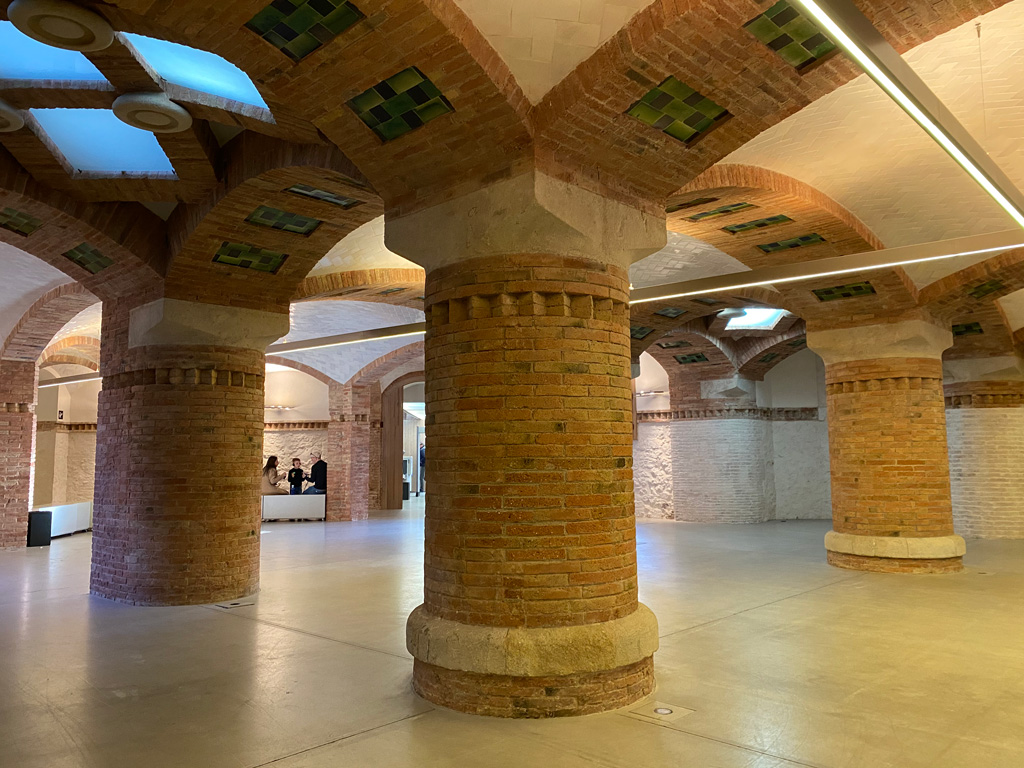
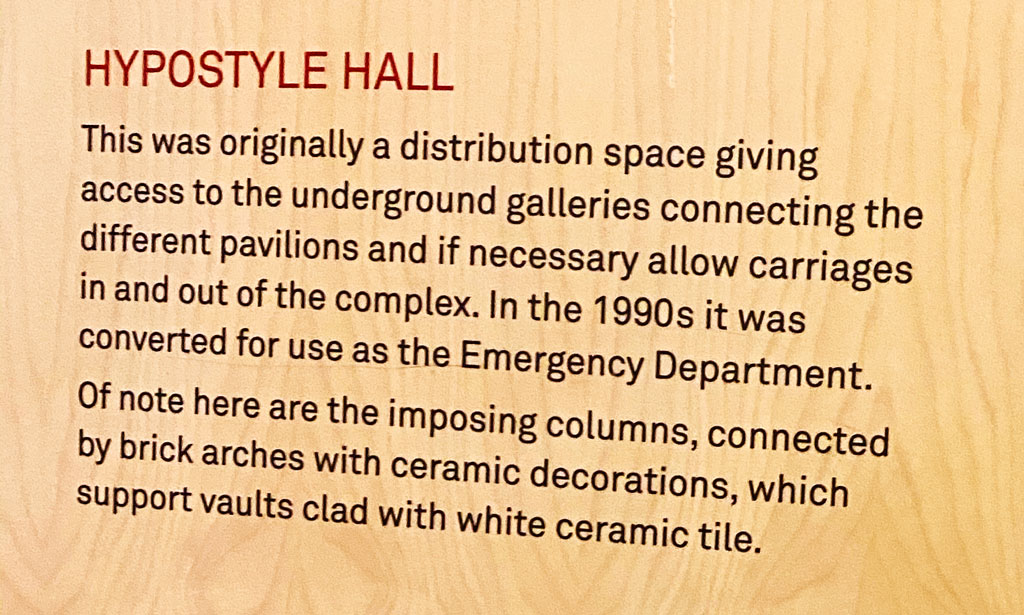
Underground Hospital Hallways
The architecturally stunning structures above ground, are connected via underground hallways. The first part of the tour goes through these hallways until you emerge into the Sant Salvador Pavilion exhibition center.
The hospital under the ground is just as awe-inspiring as above ground. The hospital has 1 kilometer of underground hallways! The halls and hallways underground are lined with exhibitions.
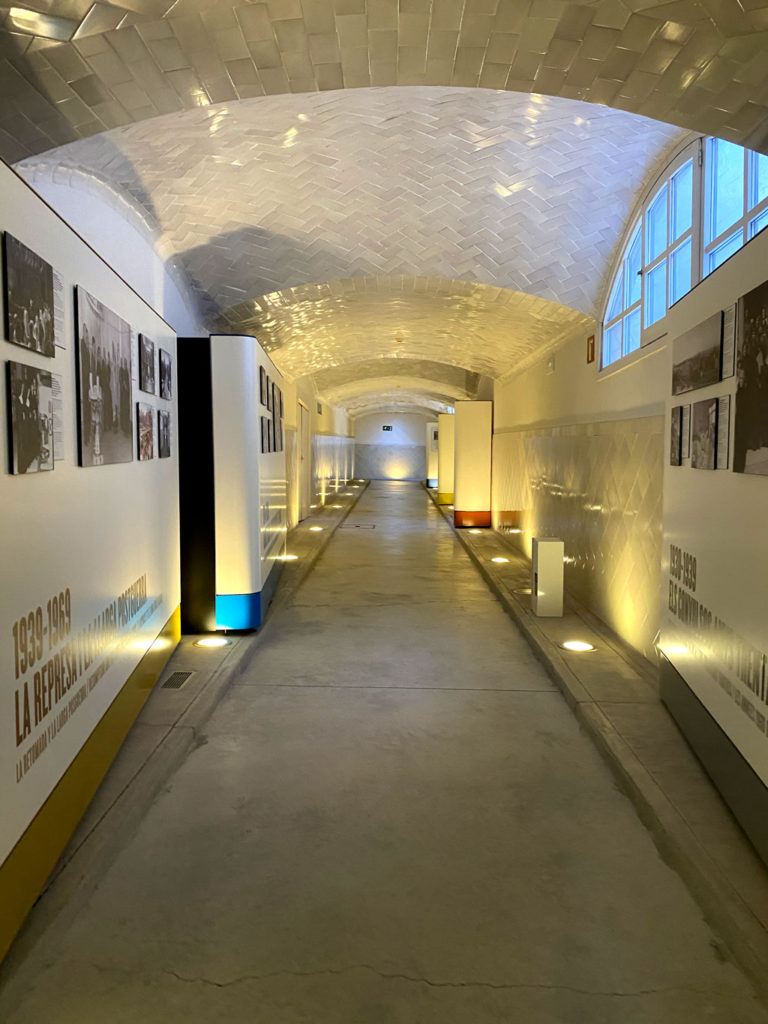
The hallways that are not used as exhibition halls have their own charm with their clean lines and off-white tile designs.
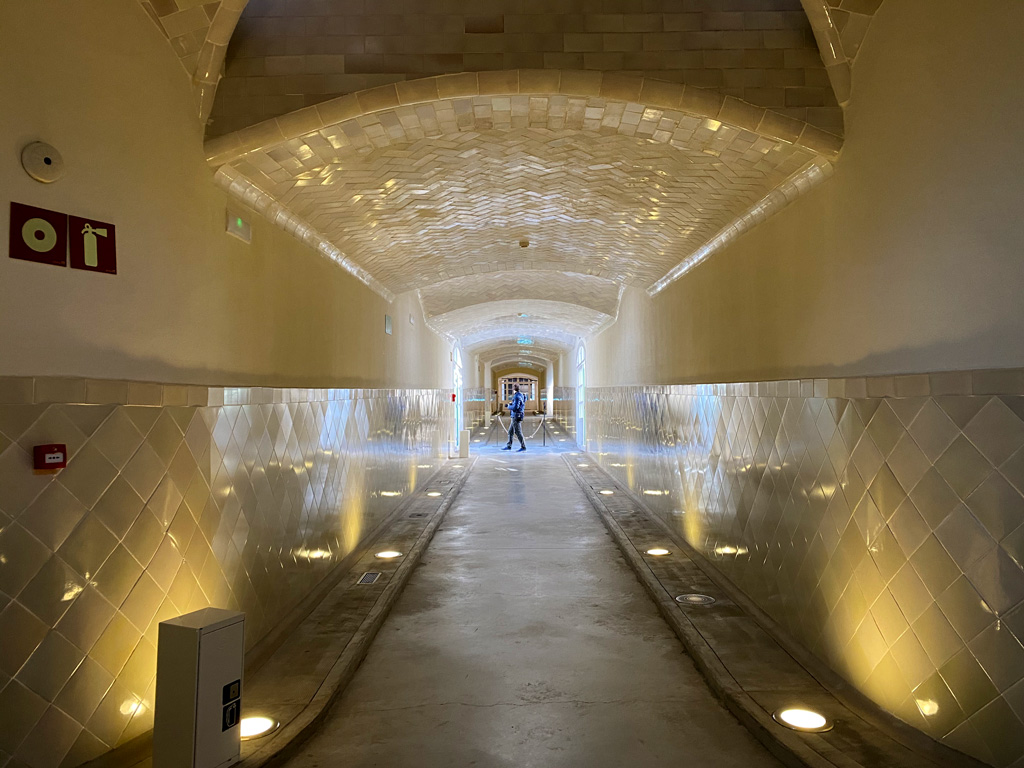
Sant Salvador Pavilion
Some of the pavilions have been converted to exhibition halls that display the tools of the trade, history and recreated spaces of the original hospital. It’s amazing to see how well the elite Catalonian hospital was managed and it’s inspiring to see how beautiful a hospital could be.
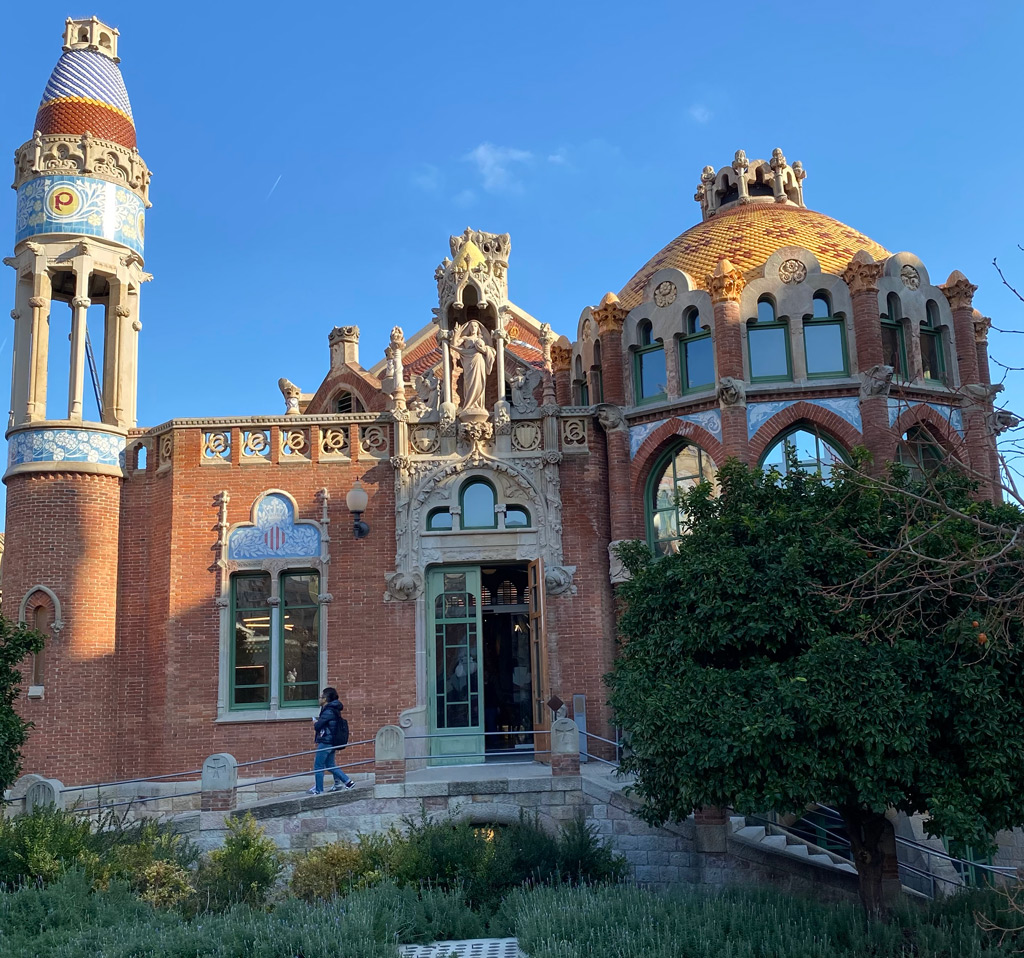
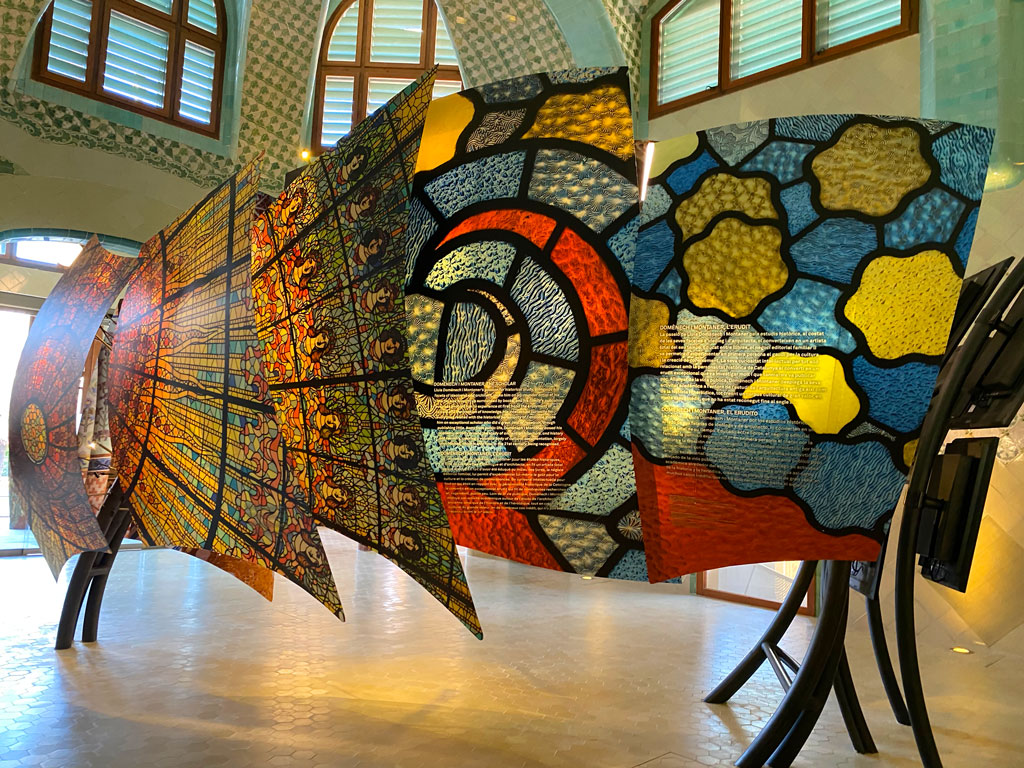
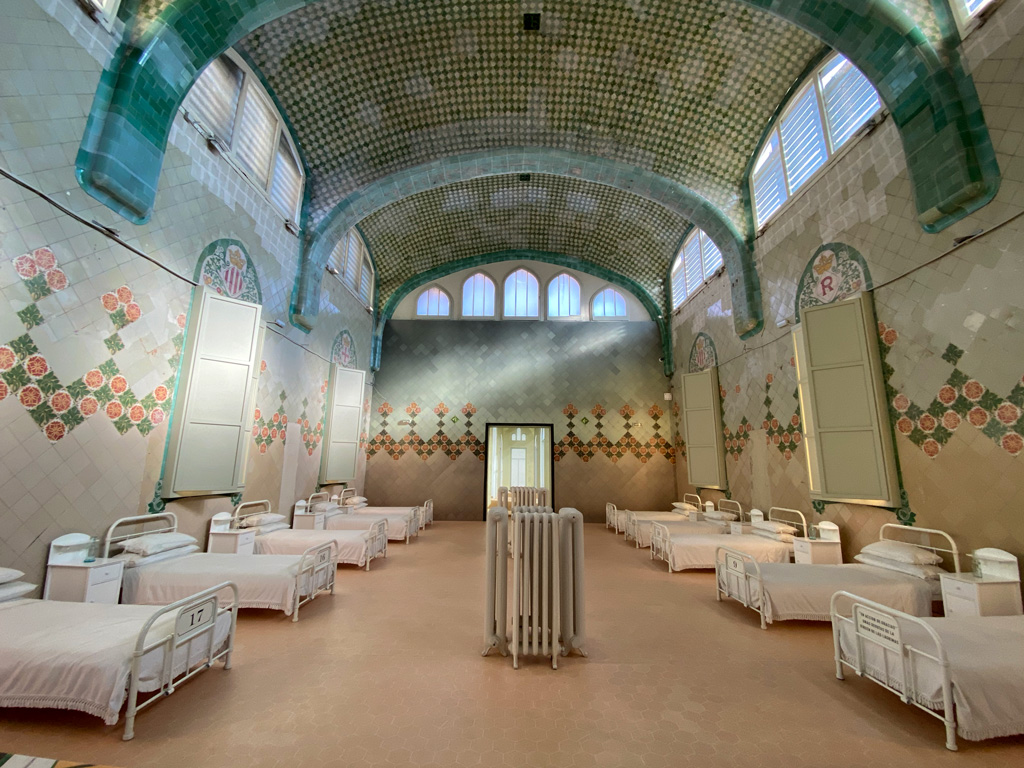
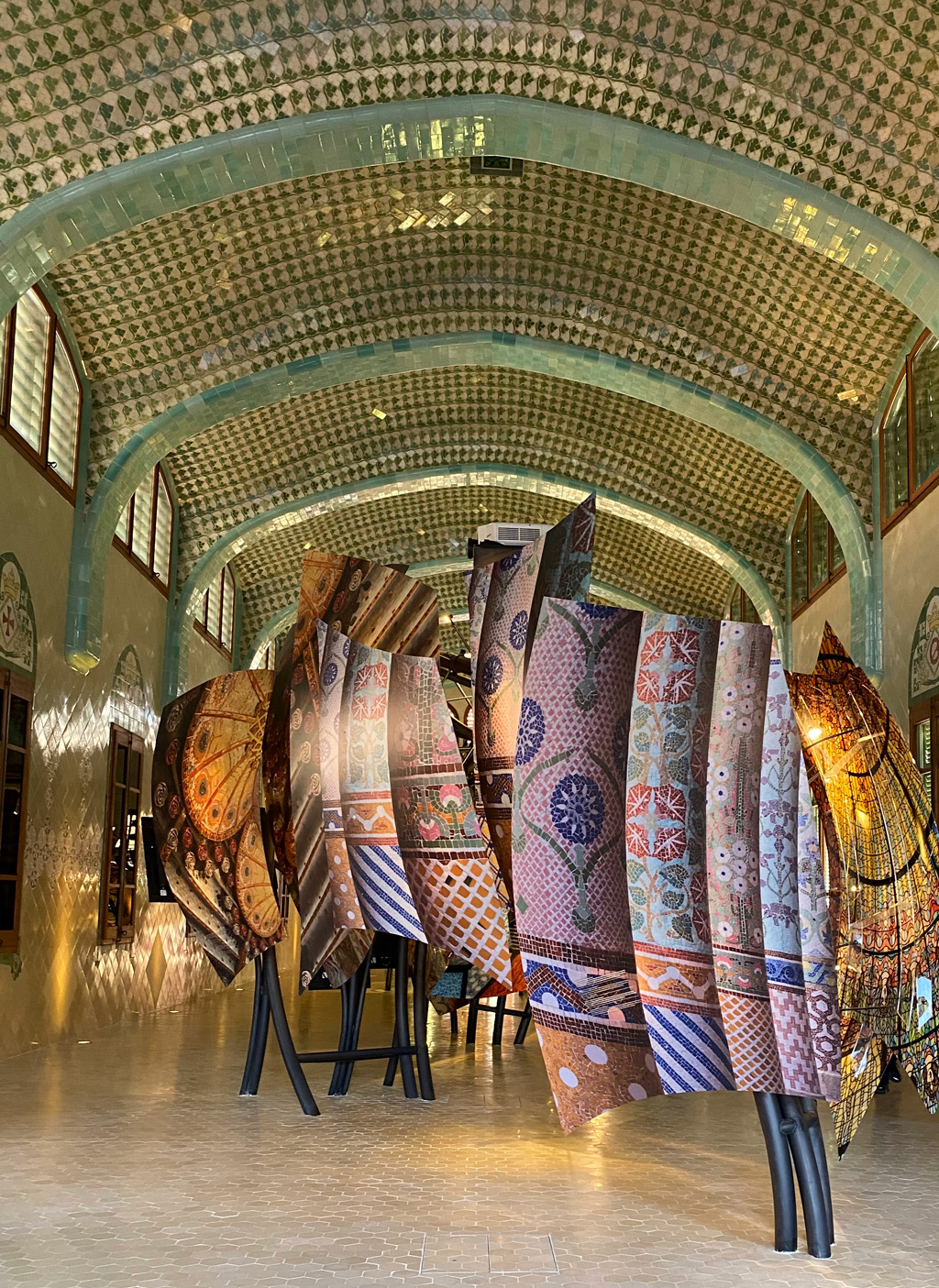
Fun facts about Sant Salvador Pavilion
Architect: Lluís Domènech i Montaner.
Financed by: Banker Pau Gil.
Year of Construction: 1902-1918.
Size 1,529 sq meters.
Restored by: Àgata Boixader and Ramon Ferrando.
Present Day Use: Barcelona’s Art Nouveau Information Center and a cultural space.
Most Recent Hospital Use: Intensive Care Unit and Semi-critical Patients.

Nostra Senyora de la Mercè Pavilion
Currently used as the WHO Barcelona office, the Nostra Senyora de la Mercè pavilion was once the department of Obstetrics and Gynecology.
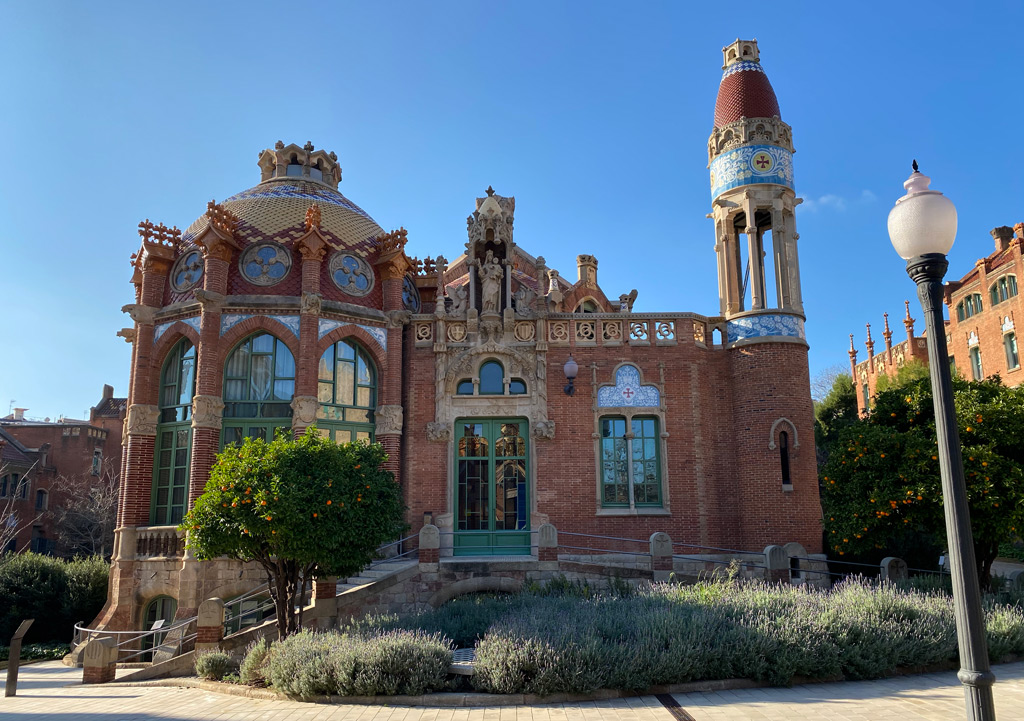
Fun facts about Nostra Senyora de la Mercè Pavilion
Architect: Lluís Domènech i Montaner
Year of Construction: 1902-1911.
Restored by: Josep Emili Hernàndez-Cros and Mercè Zazurca.
Size: 1.473 sq meters.
Present Day Use: WHO Barcelona office.
Most Recent Hospital Use: Obstetrics and Gynecology.
Sant Rafael Pavilion
Sant Rafael Pavilion is a legacy of Rafael Rabell and hence the dedication to his name. He donated part of his fortune to fund the construction of this pavilion.
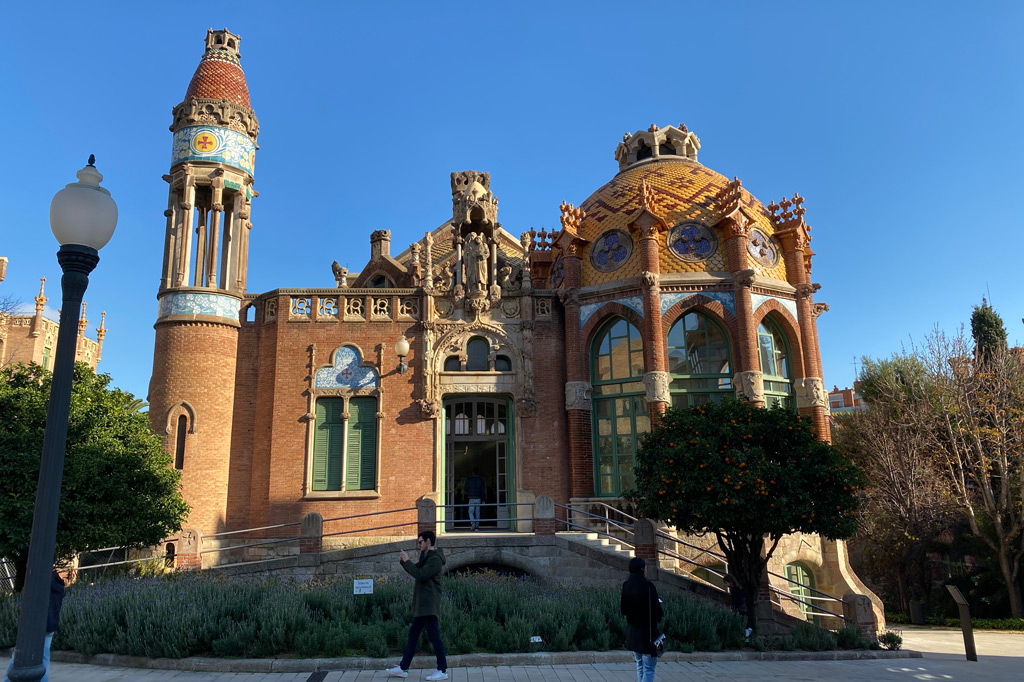
Fun Facts about Sant Rafael Pavilion
Architect: Lluís Domènech i Montaner.
Year of Construction: 1914-1918.
Present Day Use: Exhibition Space.
Primary Donor: Rafael Rabell.

Sant Leopold Pavillion
Fun Facts about Sant Leopold Pavillion
Architect: Lluís Domènech i Montaner.
Year of Construction: 1903-1918.
Size: 1,571 sq meters.
Restored by:
- Ramon Calonge consolidated the structure and restored facades, domes, and terraces.
- Xavier Guitart restored and upgraded the interior.
Present Day Use: Office of the European Forest Institute, UN-HABITAT and GUNI.
Most Recent Hospital Use:
- Internal Medicine
- Dermatology
- Teaching
- Coordinating Organ Donation and
- Tissue Bank
Sant Manuel Pavillion
Located toward the far end of the complex, the gorgeous Sant Manuel pavilion now serves as the headquarters of the United Nations University Institute on Globalization, Culture and Mobility, and Casa Àsia.
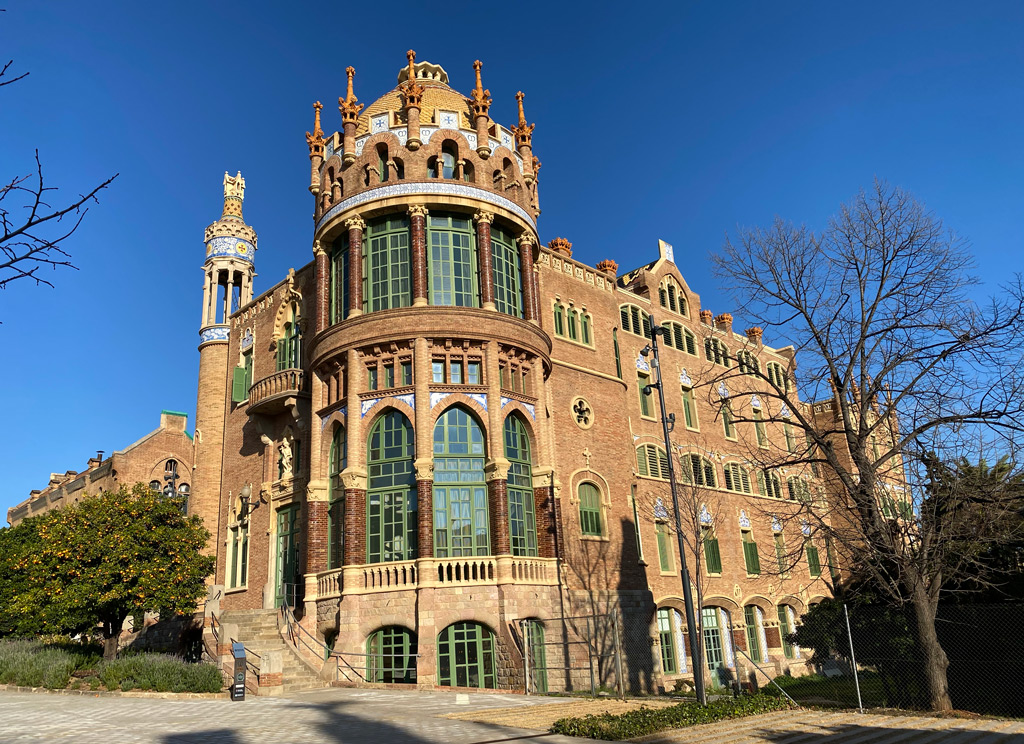
Fun Facts about Sant Manuel Pavillion
Architects: Lluís Domènech i Montaner and Pere Domènech i Roura.
Year of Construction: 1922-1925.
Builtup Area: 2,563 sq meters.
Restored by: Víctor Argentí, Albert Casals and José Luis González.
Present Day Use: Headquarters of the United Nations University Institute on Globalization, Culture and Mobility, and Casa Àsia.
Most Recent Hospital Use: General Surgery Department.

Hospital Sant Pau, end Building
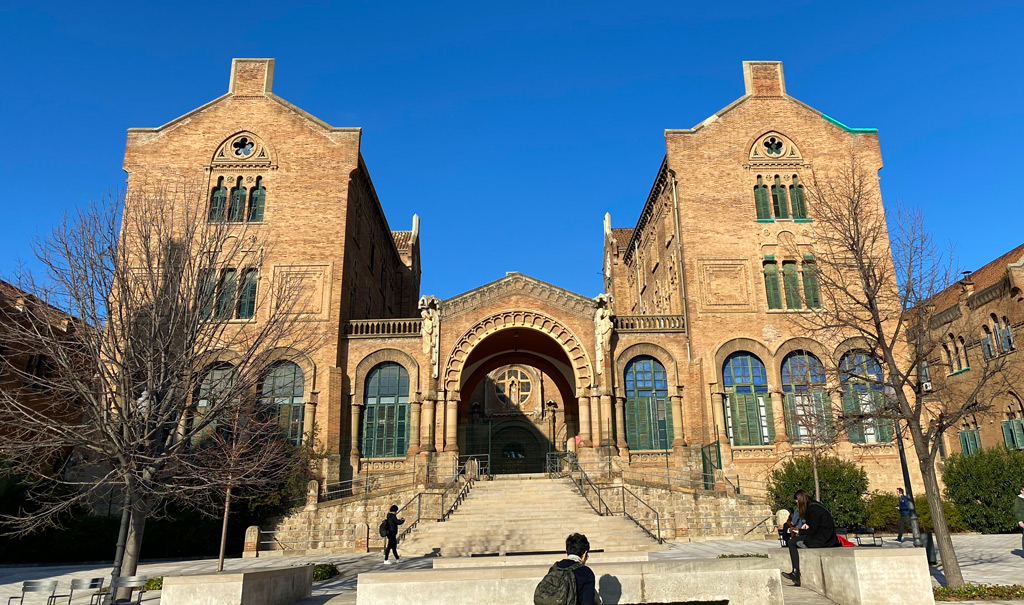
Operations House in Hospital de Sant Pau
The Operations House is located in the center of the Hospital Sant Pau complex in Barcelona. Most recently, the Operations House was used as the General Surgery Department.
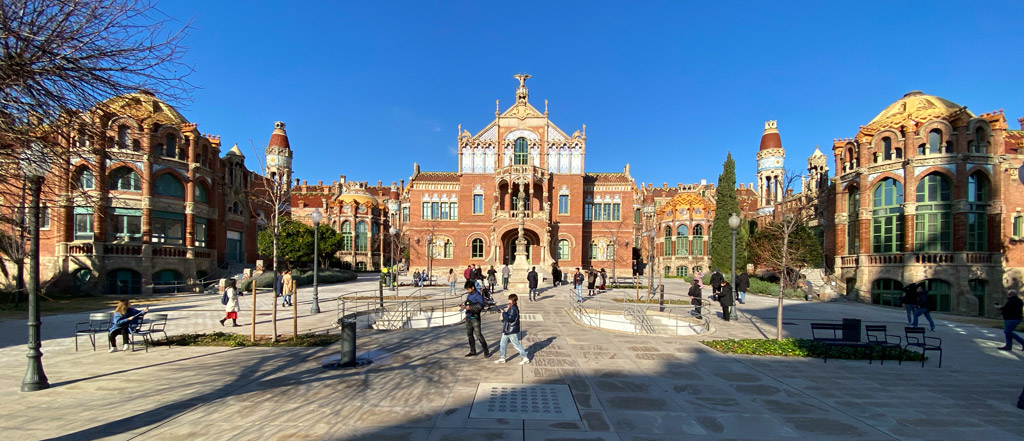
Fun Facts about the Operations House
Architects: Lluís Domènech i Montaner and Pere Domènech Roura.
Year of Construction: 1902-1911.
Builtup Area: 1,476 m2.
Restored by:
- Isabel Rodón consolidated the structure, restored the facades and roofs, and demolished non-original interior elements.
- Ramón Godó restored the interior of the underground (-1) floor.
Most Recent Hospital Use: General Surgery Department.
Santa Apol·lònia Pavillion
Fun Facts about Santa Apol·lònia Pavillion
Architect: Lluís Domènech i Montaner.
Year of Construction: 1902-1911.
Built area: 212 sq meters.
Restored by: Xavier Guitart.
Present Day Use: Exhibitions.
Last healthcare use: Dentistry.
The Administrative Pavillion
The charming administrative pavilion, with pink ceiling tiles, has been used for many administrative and hospital functions. While once it was the admission center for surgeries, now it is home to the foundation offices and used for events. On our hospital visit, the administrative pavilion was the last stop before we exit the complex.
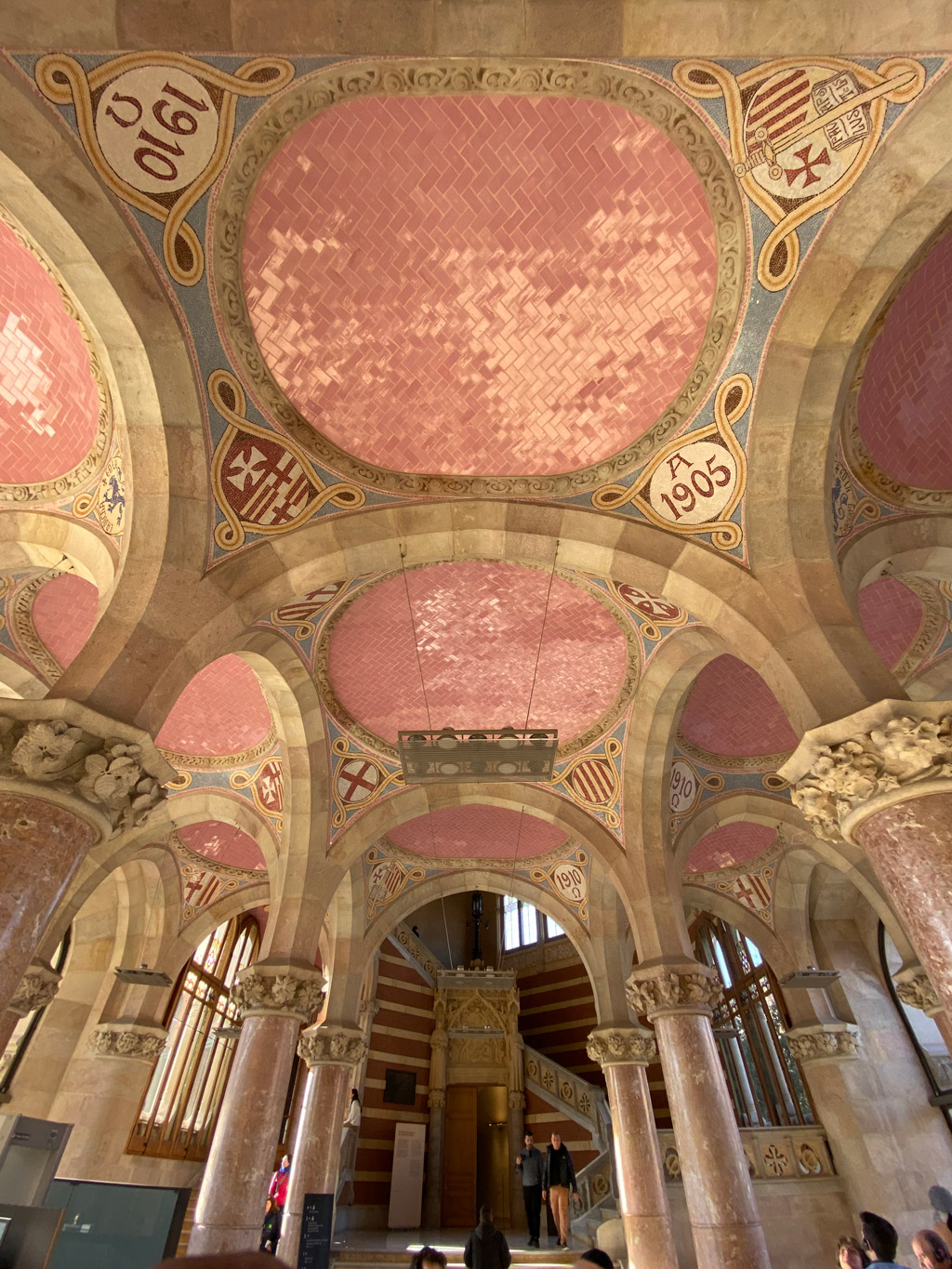
Fun Facts about The Administrative Pavillion
Architect: Lluís Domènech i Montaner.
Year of Construction: 1905-1910.
Restored by: Joan Nogué.
Size: 6,840 sq meters.
Most Recent Hospital Use: The building has seen many uses when the hospital was in us, such as –
- Hospitalization Admissions
- Department of Occupational Health
- Customer Care
- Historical Archive offices and
- Finance Department
Present Day Use: Today the building is used by Hospital de la Santa Creu i Sant Pau Private Foundation. It is also a center for Cultural events and Historical Archives.

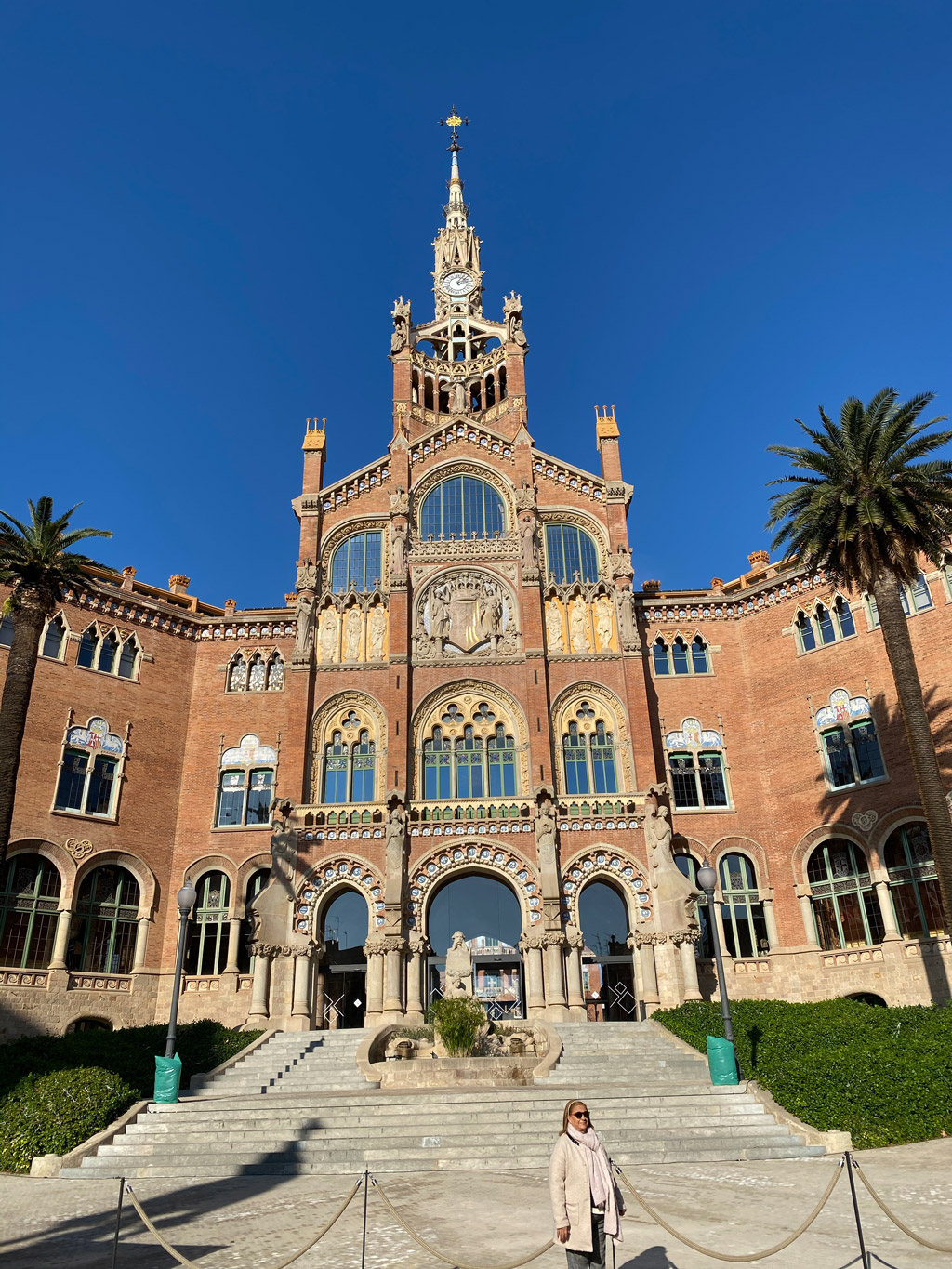
Lluis Domenech i Montaner – The Architect and Visionary
Lluis Domenech i Montaner (1849-1923) became a renowned figure in Catalonia at the turn of the 20th century. He was recognized for his dedication to the Catalan nationalism movement, academic learning, and most importantly, his architectural creations. His work is a good representation of the Modernisme style in Barcelona and Catalonia, alongside famous architects of their times, such as Antoni Gaudi (1852-1926) and Josep Puig I Cadafalch (1867-1956).
Lluis Domenech i Montaner’s illustrious career was characterized by famous architectural marvels of Barcelona like –
- Palau de la Música (1905-1908)
- Institut Mental Pere Mata in Reus (1897-1919), a project which inspired the ‘garden city’ concept that he applied to Sant Pau.
- Barcelona World Exhibition, supervised by Lluis Domenech i Montaner.
- The stunning Hospital de Sant Pau.
In addition to famous icons of architecture, Lluis Domenech i Montaner was an important public figure holding many key positions in Barcelona, such as
- President of the Unió Catalanista.
- One of the fathers of the Bases de Manresa (a program for regional autonomy of Catalonia).
- The first Chairman of the Ateneu Barcelonès.
- Member of the Reial Acadèmia Provincial de Belles Arts de Sant Jordi (1901).
- Member of parliament for Barcelona at the Madrid Cortes (1903).
By the time he was commissioned to build the Hospital de la Santa Creu i Sant Pau, he was a prominent resident of Barcelona, at the height of his distinguished political and public career.
Lluis Domenech i Montaner was born in Barcelona, dedicated is life’s work to the city and the region, and passed away in Barcelona at the age of 74 still working at the Hospital Sant Pau site. After his life, his son, Pere Domènech i Roura carried forth is work and legacy as an architect and a scholar.
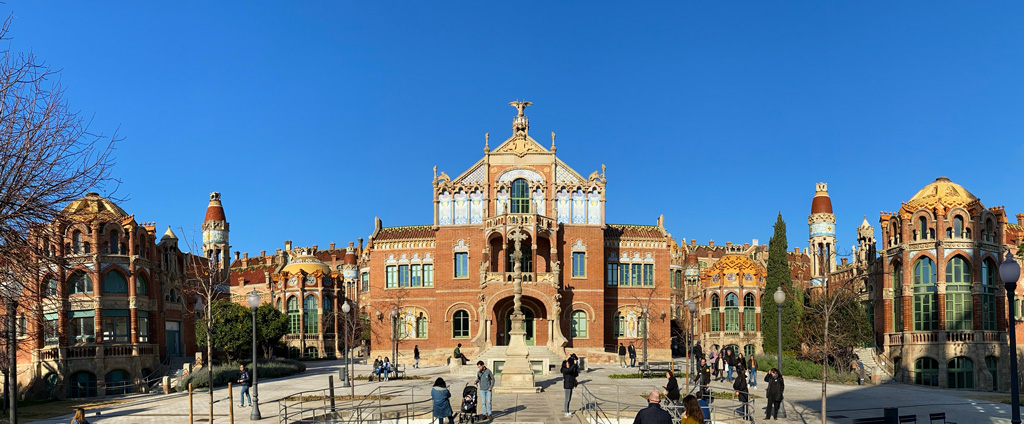
Milestones Dates in the History of Sant Pau Hospital
Following are some key milestones in the story of Hospital De Sant Pau
- 1401: Hospital De La Santa Creu was founded as a general hospital for the Catalan project.
- 1902-1918: Sant Salvador pavilion was the first pavilion to open in Hospital De La Santa I Sant Pau.
- 1902-1911: Nostra Senyora de la Mercè Pavillion, Santa Apol·lònia Pavillion, Sant Jordi Pavillion, and Operations House were built.
- 1903-1918: Sant Leopold Pavillion was built.
- 1905-1910: The Administrative Pavilion was built.
- 1916: Sant Salvador pavilion, a pavilion intended for men, received its first female patients, that were transferred from Hospital de la Santa Crue.
- 1922-1925: Sant Manuel Pavillion was built.
- 1976: First bone marrow transplant was done in Hospital San Pau.
- 1984: First successful heart transplant was done in Hospital San Pau.
- 1990s: Hypostyle Hall was converted from a distribution and carriage arrival hall into an Emergency department.
- 1991: Sant Pau hospital was awarded St. George’s Cross by the Generalitat de Catalunya.
- 2003: The new hospital building was built to the north of the Domènech i Montaner’s Modernista pavilions. Most departments relocated to the new buildings.
- 2009: Relocation was completed and the hospital was no longer used as a hospital.
- 2014: hospital de Sant Pau reopened after extensive restorations as a cultural center and museum.
Extended Campus
The Hospital de Sant Pau is a small campus within the larger working hospital. We saw hospital staff walking about on this holiday and some that look like students. Here are pictures of a few other buildings on the larger campus.
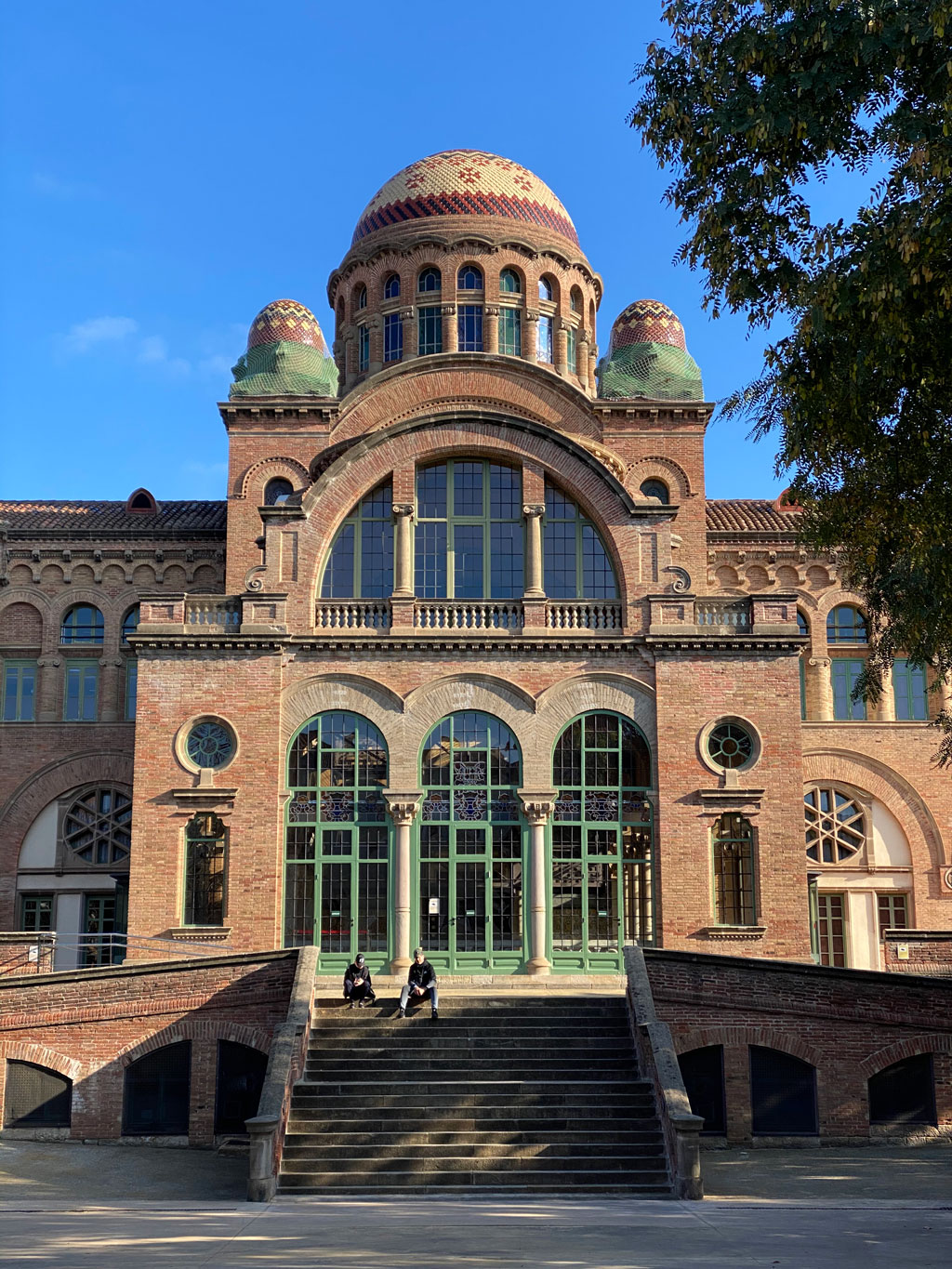
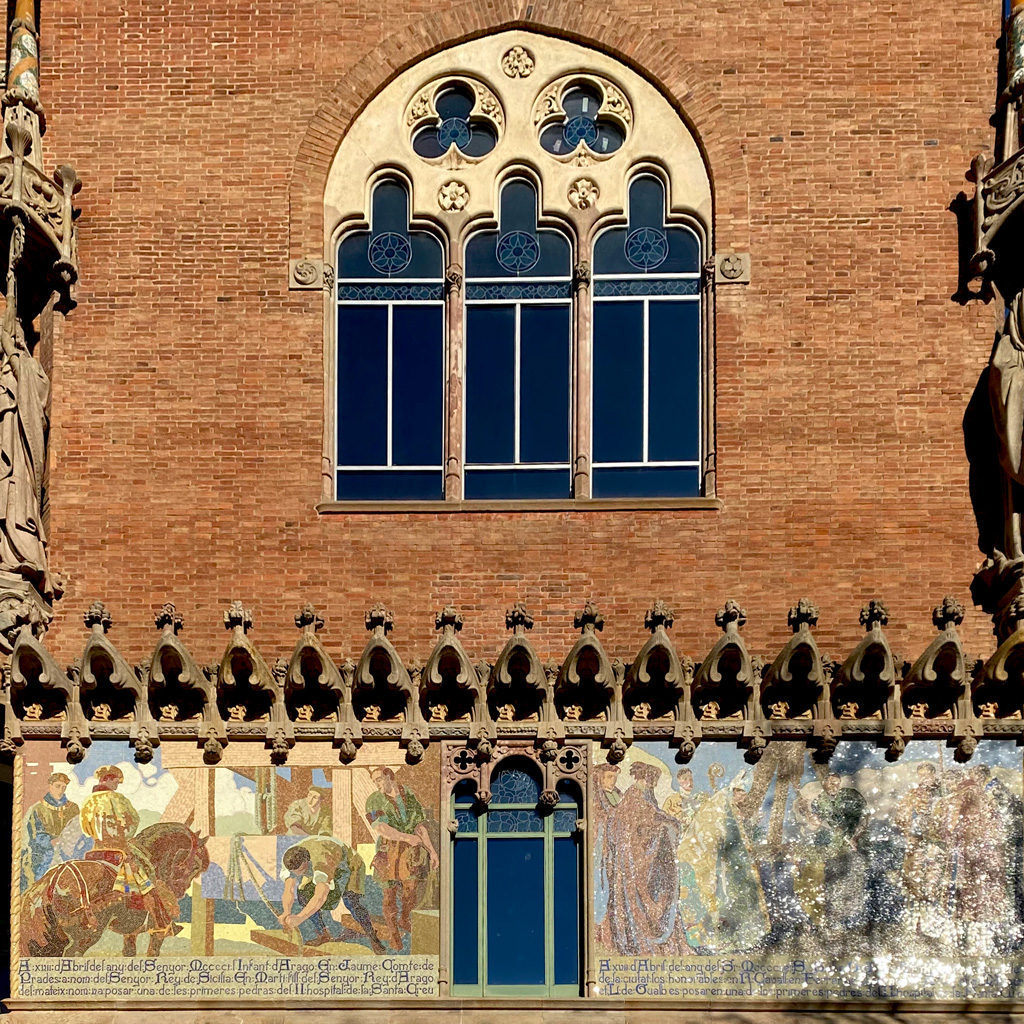
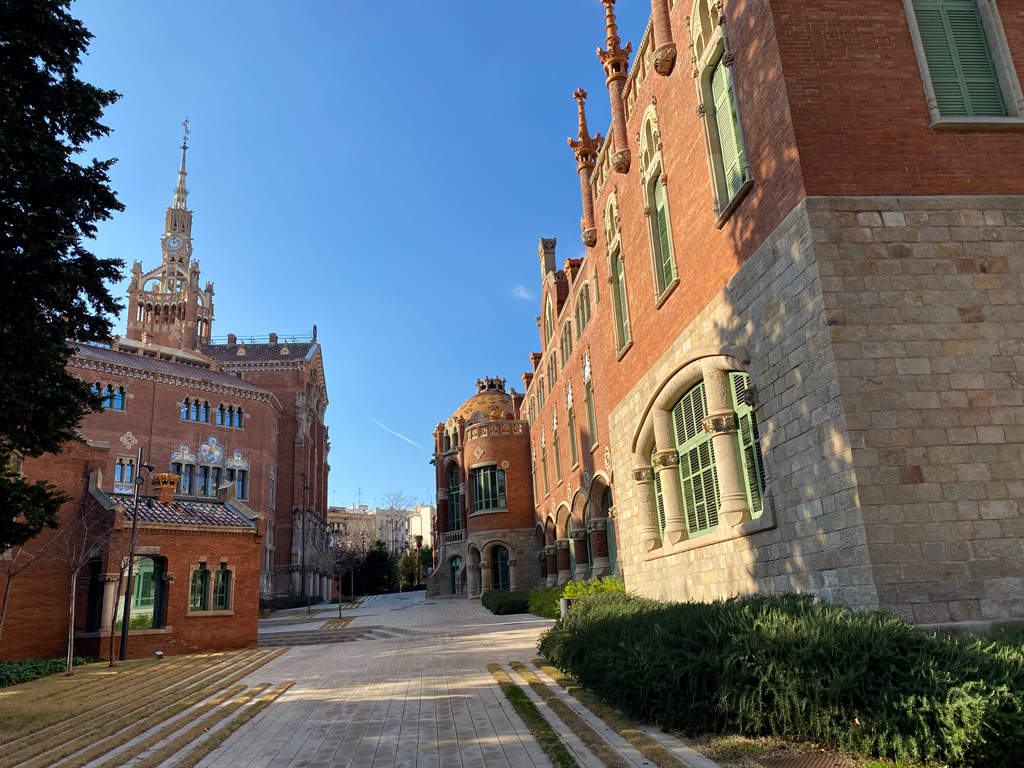
Contact Information
Address: Hospital de la Santa Creu I Sant Pau, Carrer de Sant Quintí 89, Barcelona, Spain,
Telephone: +34 932 91 90 00
Tip: The Sant Pau hospital is a straight line walking distance from La Sagrada Familia. So, best to schedule your visit to the hospital before or after La Sagrada Familia. There are many food choices on the walk between the two. We ate some amazing empanadas after our visit to Sant Pau hospital, on the walk to La Sagrada Familia.

